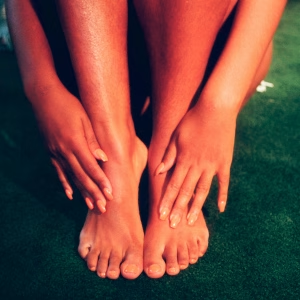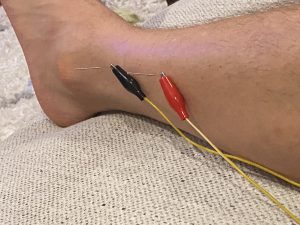Neuropathy
What do Gout, Varicose Veins, & Neuropathy Have in Common?

What do neuropathy, gout, and varicose veins have in common? In western medicine not much, aside from being awful inconveniences, ranging from sources of extreme pain to discomfort and/or a significant cosmetic preoccupation.
For neuropathy you go to the neurologist, for gout to the rheumatologist, and for varicose veins you might see your primary care, who will likely refer you to a vein specialist. The neurologist may or may not inquire about venous circulation, and it is very unlikely the rheumatologist will ask about numbness or tingling in your feet.
But from a Chinese medical perspective, all of these conditions fall under the heading of impaired circulation in the lower extremities, caused by either weakness, inflammation, or both, leading to a misdistribution of bodily fluids, which exacerbates the former, which exacerbates the latter, and so on.
They are different in specifics only as a result of individual genetic proclivities—in fundamental mechanism they are the same. Someone with a colder bodily constitution—prone more to hypothyroid or hypotension, will be more susceptible to varicosities, whereas people with warmer body types—prone more to hyperthyroid or hypertension, will be more susceptible to gouty arthritis. The former are well advised to eat plenty of lamb and red meat, while the latter might consider being mostly vegetarian.
Neuropathies can go either way in the way of temperature, as they are more telling of issues with fluid metabolism. We find that neuropathy patients are either unusually thirsty, unusually not thirsty, or they urinate excessively or not enough. In either case, their body is clearly weakened to some degree, and it is imperative they get to sleep by 11pm, so nerves can properly regenerate.
While inadequate urination obviously leads to fluid retention which can clog neurological pathways and impair circulation, excessive urination can dry vessels of their healthy synovial fluids, causing us to feel parts of our body we previously took for granted as being unaware of.
Holistic medicine should modulate the organ function that is causing the improper excretion of fluids in addition to treating local blockages causing pain or discomfort. Easier said than done of course, as such conditions generally took many years to form, plus might be aggravated by present challenges, such as diet, stress, or medications being used to treat other conditions. However, through a course of treatment of acupuncture, herbal medicines, and dietary modifications, one should see improvement over a proper course of treatment, 120 days.
Please be discerning in your choice of clinician. If you see someone—whether east or west—who is failing to assess or treat beyond the immediate site of pain or discomfort, I would highly recommend getting a second opinion.
Healing my Acute Ankle Sprain Overnight!
 Every once in a while I am reminded, by way of my own personal suffering, of the incredible power of our medicine when we “nail it,” usually thanks to the healing hands of others, but sometimes even by “representing myself in court.”
Every once in a while I am reminded, by way of my own personal suffering, of the incredible power of our medicine when we “nail it,” usually thanks to the healing hands of others, but sometimes even by “representing myself in court.”
Thursday mornings are generally the most challenging at home. I have to leave a bit earlier to get to the school downtown and teach, which means I have to prepare breakfast and the baby’s things a bit faster, and often times endure her expressions of raging heartbreak when I must break out of the house shortly after she wakes up. Last week was one such morning.
As Jillian scrambled to get ready upstairs and I to prepare to leave downstairs, Peyton found herself in a “Daddy mode,” wanting me and only me, as my wife attempted to dress and brush teeth in hyper-speed so as to not leave our very mobile, curious toddler alone downstairs. Finally, it was 7:55, my hard out. I picked up the baby, carried her upstairs in hysterics, kissed her, set her down in front of my flustered wife, scrambled down the steps, and WHAM! Rolled my left ankle inward and exclaimed in pain in lieu of shouting “I love you,” on my way out.
I’d gotten lucky. On my walk to the train I realized the sprain or strain, or whatever had just happened must have been mild, as I felt only a mild twinge of pain at the ankle. I figured this should be a quick fix while watching TV later that evening.
But over the course of the day, I observed the pain grow gradually worse, and it wasn’t because I was standing or pounding on it excessively. To the contrary, supervising student clinic shifts is mostly sedentary and physically undemanding. By the end of the shift I was truly limping, to the point that it was difficult to get down the subway steps. By the time I got off the subway it was difficult to drag myself through the tunnel at Penn Station, requiring manual use of a wall to support my limp. And by the time I got off New Jersey Transit a half hour later I was in pain even at rest and could not apply any pressure to the foot whatsoever. In all of my youthful years skateboarding and playing soccer this was easily the worst sprain I’d ever had. I hopped down the stairs one step at a time and needed a ride home from the station.
As most of you know, I am a big believer that painkillers of any form should be relegated for pain—not discomfort—as my opinion is the laissez faire way in which they are ingested likely contributes over time to malabsorption in the gut, which is a primary etiology for many diseases. However, they do have their place, and this was one of them. With both sides of my ankle now throbbing, even while elevated on the couch, I ate some soup and took the max dosage of ibuprofen. From there the pain subsided and I returned to Chinese Medicine.
San Huang San is an empirical treatment for the first stage of such injuries. Nicknamed “herbal ice,” it reduces inflammation even more powerfully, but instead of constricting local blood circulation it enhances it, and I desperately wish all professional athletes knew about this ancient cure. I hopped into the kitchen, cracked an egg into a bowl, removed the yolk, and poured the herbal powder in with the white part to make a poultice. Stirring, stirring, stirring furiously, while my ankle pounded, pounded, pounded furiously with pain, I was determined to get back to the couch and begin this healing process as soon as possible.

Step 1: Bleed the “jing wells.” Jing well points are the first on each meridian, which means ends of the fingers and toes. It’s not always the most pleasurable experience, but pricking these points with a lancet to drain stagnated blood along the channel of physical trauma is a great way to begin the anti-inflammatory process by making space for new blood to come in. It’s a bit psychologically challenging to do on one’s self, but I managed, on the ends of both the big and fourth toes.
Next I used a spoon to apply my brown pasty, egg-white-based poultice to the entire ankle and wrapped it all up with bandages from our medicine cabinet. When the ibuprofen kicked in, I was no longer in pain at rest, but still was unable to put any weight whatsoever on the foot. That night I chose to sleep on the couch downstairs, as opposed to thunderously hopping up the steps and surely waking the baby.
Before bed I did acupuncture: Two points along the posterior tibial nerve pathway that innervates the medial malleolus (inner ankle), and two points along the peroneal longus and brevis respectively, which innervate the lateral malleolus (outer ankle). 15 minutes on each side, a protocol I was about to great practice in performing in the week to come.
I canceled my entire workday on Friday (sorry everyone), just praying that things would be manageable by Monday. When I woke up the next morning I was not in pain at rest, which meant I could put the Advil away for now. Before choosing to hop to the bathroom I thought I’d give a very light limp a try. I braced myself by my arm up against the living room wall and put the gentlest pressure I could muster onto the floor. No real pain. “Heyyy, that’s at least some improvement!” I took another step, this time cautiously applying even more pressure, and again noticed zero to minimal pain.
In my 20 years as a patient of Chinese Medicine, that walk from the couch to the bathroom was one of the most awe-inspiring, amazed experiences I’d ever had. With every step I applied more pressure and with every step I felt more gratitude and disbelief. I knew the reputation of San Huang San powder. I’ve used it on patients as well as on myself before, but I’d never seen it work at this speed with this degree of efficacy. My ankle was 80-90% better literally overnight. I almost thought twice about calling my patients to reschedule the afternoon, but with the help of a more level head from my better half I thought better of it and took the day to rest. Instead, and to satiate my Type A workaholism I purchased an online webinar by one of my mentors and spent the day studying. I am now one week removed from the sprain and feel 100% better.
Most people are aware of Chinese Medicine’s efficacy at treating chronic pain and injuries, but don’t realize that many such protocols, powders, formulas, and treatments were created and developed to treat injured soldiers in the ancient times of China’s warring states. Instead of the western RICE method, which even its creator, Dr. Gabe Mirkin, has conceded as wrong, please don’t hesitate to reach out the next time you sprain an ankle, break a bone, or tear a ligament. Like the smartphone saying, “There’s an app for that,” in Chinese Medicine we might echo, “There’s a treatment for that.”
Acupuncture and Peripheral Neuropathy Relief

According to the National Institutes of Health, approximately 20 million people in the United States suffer from peripheral neuropathy. The NIH also notes that it is particularly common among those suffering from diabetes. So, what is peripheral neuropathy and can acupuncture help to relieve its symptoms? continue reading


